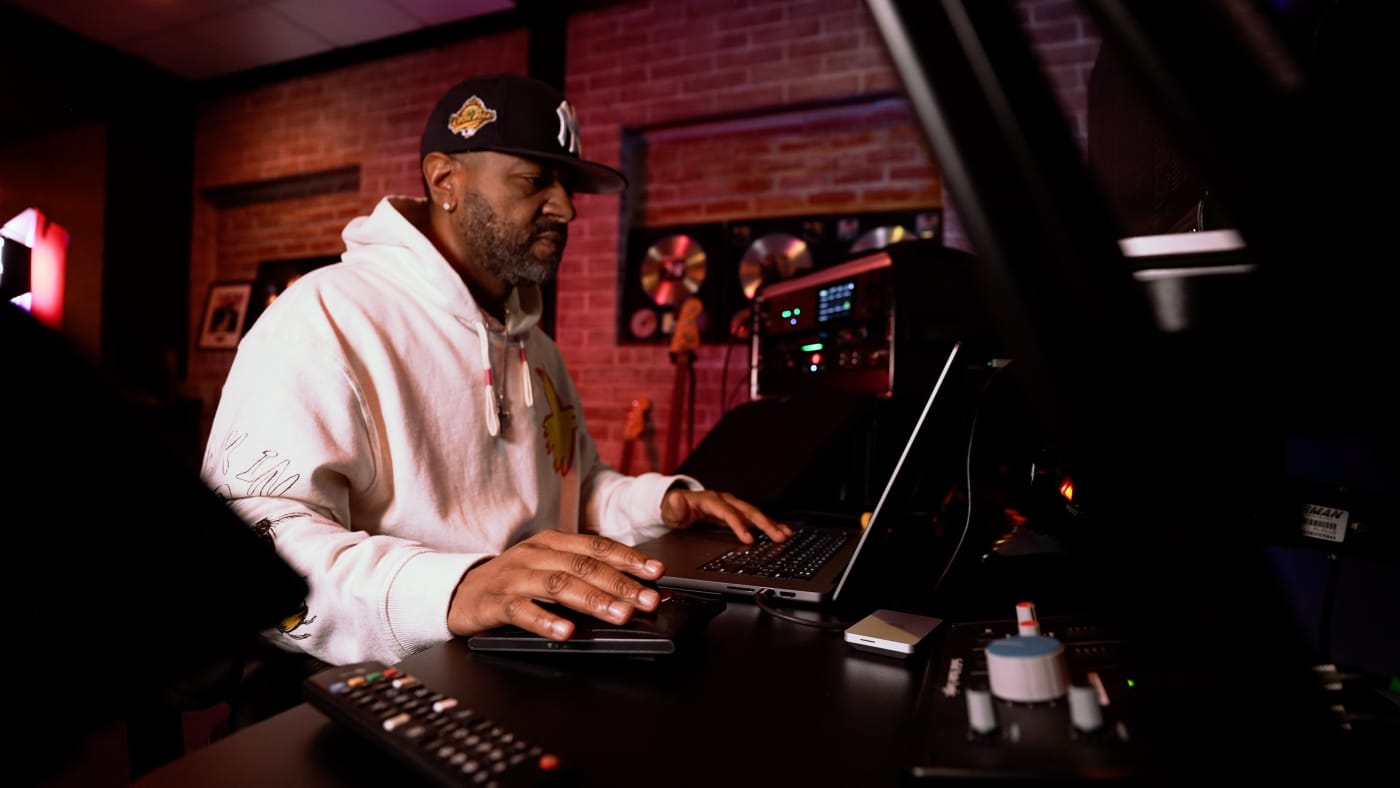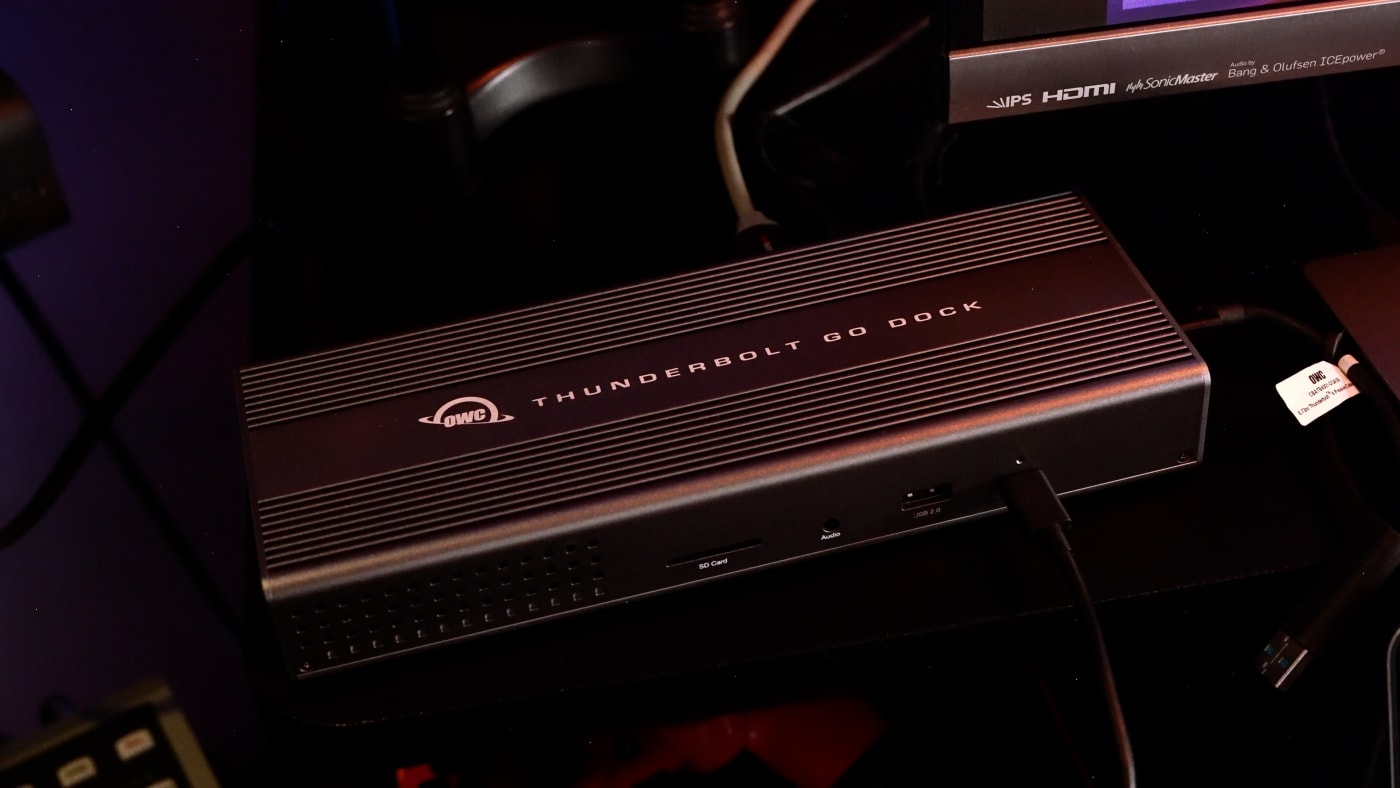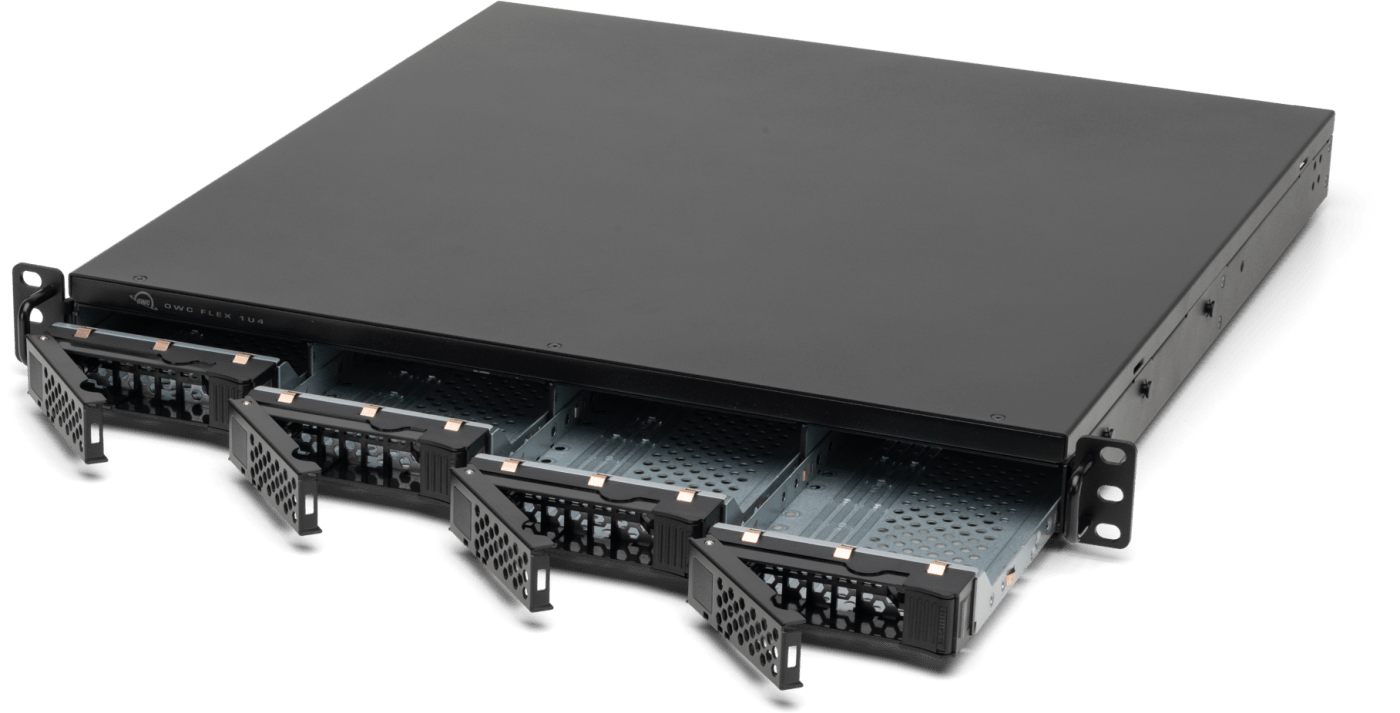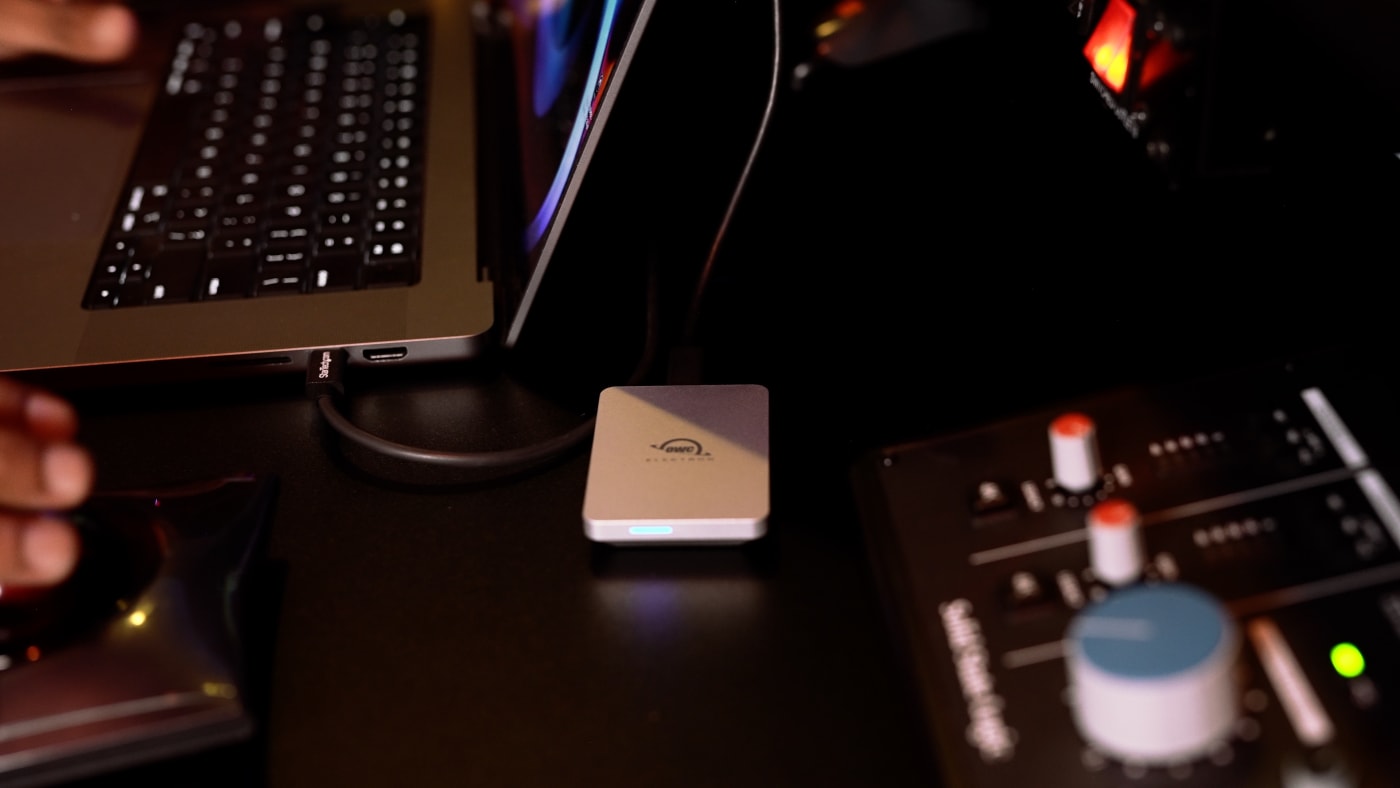Everything is Connected: Engineering a frictionless workflow with producer Adrian “AP” Porter
Whether he’s creating music, producing a track or dreaming up the next big live show for superstars like Usher, here’s how Adrian “AP” Porter make sure his tools will connect without a problem each and every time.
Wayne Grayson • Jul 09, 2024

Perhaps more than any other created professional, musicians and music producers live and die by the cable.
Musicians can make a lot of great things with just a Mac, PC, or even an iPhone thanks to the incredible digital tools and apps at their disposal. But when it comes time to lay a truly polished track down, you’re always going to need more than a screen and keyboard.
Microphones, soundboards, copious amounts of external hard drives, and of course, instruments: they’re all essential tools in creating the sound that matches whatever is humming in your head and heart. And the more audacious you get in your music making, the more tools you’ll likely need to connect to your primary device create that sound.
Nobody is a better example of that than Adrian “AP” Porter. AP is a musician, producer, engineer, programmer and sound designer that has worked with some of music’s biggest acts including Usher, Cardi B., Sierra, Eric Clapton, and more. Because he wears so many hats for so many big acts, AP is constantly in motion, moving from one studio and rig to the next.
And what is absolutely crucial to his work is knowing that no matter where he is his tools will connect without a problem each and every time.
“One of the biggest challenges I face is connectivity,” AP says. “I work in a lot of different situations and scenarios, I work from home as well, and I need to be able to leave one place, come back to the studio and be able to jump right back into a session and I need everything to work seamlessly.”
To his contemporaries in the music business and especially in his hometown of Atlanta, AP is simply “that dude.” He combines an ear for great sound with a technical prowess matched by few others in the business.
So, we wanted to pick his brain a bit and get a better understanding of how AP crafts his workflows and the tools he relies on to put on some of the biggest shows on Earth.
The Backbone
Though AP spends his fair share of time in the studio as a producer, he’s also the driving force behind some of the biggest live shows on the planet. For instance, AP is the architect and engineer behind Usher’s live shows, including his 2023 residency in Las Vegas and the R&B superstar’s incredible 2024 Super Bowl halftime show.
That means in addition to his production responsibilities, AP has the full-time job of producing an incredible live show experience for multiple huge artists both on the road and in residencies like Usher’s last year.
So, AP can find himself at work in several very different environments. But he always has to be ready to produce or design with his multitude of drives, boards, and plugins. For AP, a dock is the backbone to the whole operation.
“I always have my backpack. So, usually wherever I’m at, the first thing I do is sit the laptop down,” he explains, the laptop being a M1 Max MacBook Pro. “And the first thing after that is the dock.”

AP’s go-to dock is the OWC Thunderbolt Go Dock. The Go Dock supports USB-A, USB-C, and up to three Thunderbolt connections, in addition to an SD card slot, audio jack, HDMI 2.1, and 2.5 gigabit Ethernet. But what makes Go Dock truly unique is that it eschews the large power brick that most Thunderbolt docks require thanks to its internal power supply.
For AP, the Go Dock lets him connect all of his midi controllers, drives, displays, and other tools while keeping his MacBook Pro charged—and all without the extra bulk of a power brick. That means the Go Dock never leaves the backpack.
But that’s not the only dock he depends on. In a studio setting, AP keeps all of his more static setups connected via the OWC 14-port Thunderbolt Dock. The 14-port Dock is the king of desktop expandability, offering two Thunderbolt ports, a USB-C port, and five USB 3.1 ports, making it perfect for connecting all of your edit, backup, archival and shuttle drives.
“Getting all of my Dante connections, external drives, and ProTools up and running is so quick,” AP says. “I love these docks. There are sessions I’m working on that if it all goes down due to a drive failure or something getting disconnected, that’s millions of dollars and an artist’s live show potentially being cancelled.”

Big Boy: The road warrior
Like any music artist, just because you’re on the road touring work that has already been completed, doesn’t mean that creativity ceases. The gear that AP takes with him on the road has to be capable of storing new sessions, quickly pulling up archived sessions, and then quickly being being backed up and synced to his home and studio server storage when he comes off the road.
There’s only one professional storage solution that can be all of these things at once for AP, and that’s the OWC Flex 1U4. The Flex 1U4 is a four-bay, rackmount solution that supports up to 92TB of storage with Thunderbolt transfer performance, drive flexibility, and device expandability.
But the Flex is much more than just a RAID-capable server. It also has docking capability, allowing you to connect keyboards, mixers, cameras, displays, and more with two USB-C ports and three USB-A ports alongside a Display 1.4 port that supports displays up to 8K.
AP has the Flex 1U4 rack installed at his home studio. But thanks to the Flex 1U4’s four removable drive bays, he can quickly grab a drive bay with all the storage capacity he’ll need for a road trip. While on the road, AP can record to and shuttle sessions from his Envoy drives and then back them up to a Flex 1U4 drive bay, which are Thunderbolt-powered and can hold spinning hard drives or multiple U.2 NVMe SSD blades.
Once he’s back home, everything created and recorded during the trip is seamlessly archived by slotting the drive bay back into the Flex 1U4 rack.
“The Flex houses everything for me. I’m using a multiple SSD configuration in each drive bay on a RAID and that’s all backed up in the cloud via a Dropbox sync,” AP explains. “And I always keep one Flex 1U4 drive bay with me to house my sample libraries.”
AP says that he houses the sample libraries on that dedicated Flex drive bay because each Flex drive bay can houses tens of terabytes worth of data thanks to those multiple U.2 NVMe blades. And because those blades transfer data so quickly via Thunderbolt, AP can swap between sample library setups very quickly.
AP lovingly refers to the Flex 1U4 as Big Boy, because his workflow revolves around it.
“I love the Flex 1U4,” he says. “Every work and project session is on the Flex, which is also connecting my external displays.”

Freedom to move
While docks are the backbone to AP’s workflow, keeping all of his tools connected wherever he is working, and the Flex 1U4 gives him the power and ability to keep his server and RAID backup synced after long stretches on the road, his external drives are equally if not more important.
After all, these are the drives storing and shuttling around the latest work from artists like Usher, Sierra, Chris Brown, and others. So, when it comes to external drives, failure is simply not an option.
And because AP is constantly on the move, durability, capacity, and speed are all must haves. For that reason, AP depends exclusively on OWC Envoy drives, including the small but mighty Envoy Pro Elektron, and the blistering speeds of the Thunderbolt-powered Envoy Pro FX.
Envoy drives are the perfect companions for musicians and producers because they can house thousands of sessions, tools, and digital instruments and be thrown in a bag or even a pocket without worry about corrupted data.
“There can be no failures when we’re talking about sessions with these clients. No glitches, no corrupted files,” AP says. “My Envoy drives are always with me. These drives hold down my operation and are truly professional tools.”
Simple from the outside
Within the industry, AP is known not just for his chops a producer and musician, but also for his workflow and tools. There’s simply not a technical problem he can’t solve—a necessary trait in someone tasked with building the audio for the live shows of multiple megastars—and that’s evidenced by the way he has removed all possible friction from each step of his workflow.
“People are always wondering how I’m able to be as flexible with regard to when and where we can work because the configuration seems so simple. You don’t see a lot of cables,” he says.
That’s not a coincidence. AP has—and continues to— put a lot of thought into his workflow. His use of docks, drives, and the Flex 1U4 is nothing short of an elegant solution to the unique demands of his process.
“I rave about these tools all day, every day,” he says. “I have a lot of tools to connect and a lot of important data to move around. The connection has to be flawless in the moments I’m at work with my clients and that’s why I’ve loved and used OWC products for so long. They provide unmatched stability and reliability.”